Abstract
Carabidae, or carabids, commonly known as “ground beetles”, are found in numerous natural and cultivated habitats and are recognized for their beneficial role in controlling phytophagous pests in various temperate agroecosystems. However, the crop type and agricultural practices used in management areas significantly affect the structure of the carabid communities. The aim of this study was to investigate the abundance and diversity of ground beetles in hazelnut agroecosystems characterized by different agricultural methods in Calabria, Southern Italy. The carabids were collected from 2017 to 2018 in three hazelnut groves referred to in this study as AZ1, AZ2 and AZ3. Carabids were sampled using pitfall traps inspected every two weeks over a period of 24 months. A total of 4665 specimens belonging to 48 taxa were collected within the sampled sites. Many taxa were found to be widely distributed across the three selected hazelnut groves. Among these, Calathus spp., Harpalus dimidiatus (P. Rossi, 1790), Nebria spp., Platyderus neapolitanus jannonei (Binaghi in Magistretti, 1955), Poecilus cupreus (Linnaeus, 1758), Pterostichus melas italicus (Dejean, 1828), and Syntomus obscuroguttatus (Duftschmid, 1812) were the most abundant ones associated with all sampled areas. Concerning trophic preference, among the collected taxa, the most abundant ones were zoophagous and zoospermophagous. Additionally, taxa uncommon in agroecosystems but with ecological relevance, such as Carabus lefebvrei lefebvrei Dejean, 1826, Carabus preslii neumeyeri Schaum, 1856, and Carabus rossii Dejean, 1826, were also collected.
1. Introduction
Groves of hazelnut, Corylus spp. (Fagales: Corylaceae) and of olive, Olea europaea L., 1753 (Lamiales: Oleaceae) are relevant agroecosystems in southern Italy. In some areas of Calabria (Southern Italy), hazelnut crops have historically been extensively cultivated, providing employment to rural populations for many years. Recently, although current hazelnut production in Calabria has decreased compared to the past, there has been a rediscovery of the landscape value of native hazelnuts and their economic impact [1]. In order to protect and enhance the value of hazelnut groves, a consortium named “Valorizzazione e tutela Nocciola di Calabria” (“Valorisation and protection of the Calabrian hazelnut”) has been established by the growers of the Torre di Ruggiero and Cardinale municipalities, within the province of Catanzaro [1]. In Europe, hazelnut fruits are susceptible to damage by numerous pests, such as Coleoptera, Diptera, Lepidoptera, Orthoptera, Rhynchota and Acarina, leading to crop losses and a reduction in product quality [2,3,4]. Globally, pest control in various agroecosystems employs different soil treatments (such as crop rotation, timing of planting, and physical controls), as well as pesticides and beneficial organisms for pest management [5]. In many agroecosystems, including hazelnut groves, Carabidae, or carabids, commonly known as “ground beetles”, are recognized as both agents of biological control against phytophagous insects, a food source for various vertebrate species [6,7], and as relevant bioindicators [8,9,10]. Given their importance within food chains, populations of ground beetles need to be protected [6] because they may feed on small invertebrates, including the immature stages of phytophagous, that cause damage to crops and other agricultural products [9,11,12,13,14]. Studies on carabid assemblages conducted in agroecosystems indicate that intensive farming significantly affects the community structure of ground beetles [9]. In hazelnut groves, the use of biological methods (e.g., polypropylene fabric, bark, or sawdust to cover the soil) appears to be beneficial to the presence of carabids [7].
To investigate the carabid community in hazelnut agroecosystems, our objectives were to study the composition and abundance of taxa of ground beetles in hazelnut groves, to examine the relationship between the cultivation methods used at each site and the taxa composition, and to analyze the abundance, chorotype, trophic preference, and wing morphology related to taxa dispersion.
2. Materials and Methods
2.1. Study Sites
As part of a research project focused on studying insect communities in various habitats of the Calabria Region (Southern Italy), an entomological investigation was conducted in an area located between the municipalities of Torre di Ruggiero (Catanzaro) and Cardinale (Catanzaro). The study was conducted from 2017 to 2018, for a total duration of 24 months. Three hazelnut groves, AZ1, AZ2, and AZ3 (Table 1), for a total of approximately 8 hectares, were selected for ground beetle sampling. Each site was located approximately 300–400 m apart from the others, with boundaries delimited by roads and ecotonal areas (Figure 1). The elevation of the groves ranged from 600 to 750 m above sea level. The soil at the sampled sites was a mixture of sand and silt, predominantly composed of granite and granodiorite [15]. The climate in the areas was characterized by high humidity and abundant annual precipitation, with 1.218 mm in 2017 and 2.416 mm in 2018. The maximum temperatures recorded were 30.2 °C in 2017 and 29.4 °C in 2018. In winter, the minimum temperatures were 2.9 °C in 2017 and 7.9 °C in 2018 (cod. 1960) [16]. The three groves were surrounded by oaks, Quercus ilex L., 1753 and Quercus pubescens (Willd., 1805) (Fagales: Fagaceae), and shrubs, Erica arborea L., 1753 and Arbutus unedo L., 1753 (Ericales: Ericaceae).

Table 1.
Characteristics of the hazelnut groves (AZ1, AZ2 and AZ3) sampled during 2017–2018.
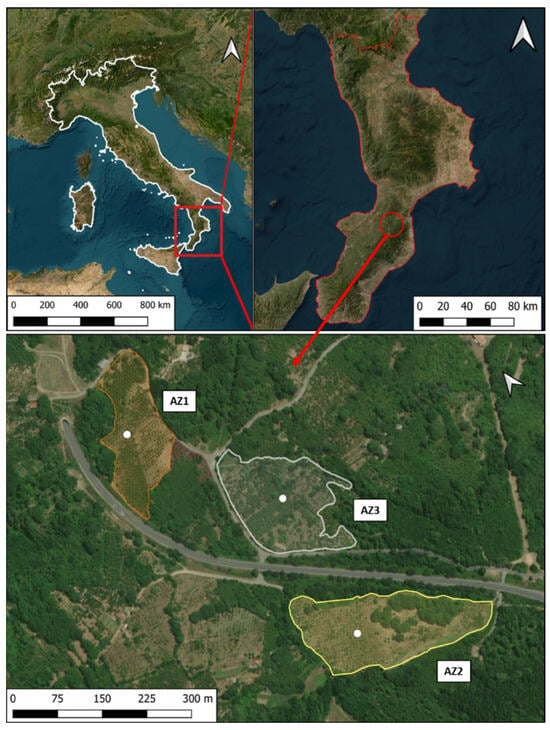
Figure 1.
Sampled hazelnut groves (AZ1, AZ2 and AZ3) located between the municipalities of Torre di Ruggiero and Cardinale (Catanzaro), Calabria (Southern Italy). Satellite views (Google Earth) modified by QGIS software (https://qgis.org; version 3.34.2; accessed on 28 February 2024).
The sampling sites, characterized by spontaneous herbaceous vegetation (grasses and legumes), underwent different soil management practices and hazelnut plant treatments. In 2017 and 2018, during the first 15 days of June and July, the site AZ1 underwent two pest control treatments per year using natural insecticides based on pyrethrum, applied directly to the tree foliage. In the same site, the soil underwent mechanical cutting of the herbaceous layer once a year. In the same years, site AZ2 underwent mechanical soil tillage once a year, and foliar treatments two or three times a year by copper sulfate, to control pathogen fungi. In the same site, copper sulfate was also applied to trunks two times a year in 2017 and 2018. In the same years, site AZ3 did not undergo any mechanical soil treatment nor chemical treatment (Table 1).
2.2. Carabid Sampling
Insects were collected over a two-year period (from 2017 to 2018) for 24 months, every two weeks, using pitfall traps [17,18,19]. The traps were filled to two-thirds of their capacity with a saturated mixture of white vinegar and salt, then positioned in a way that the rim of the inner container was flush with the ground. Five traps were randomly positioned at each experimental site, resulting in a total of 15 traps. Each trap was activated, checked after two weeks, and then reactivated. Collected individuals were identified to the species and (sometimes) subspecies level using taxonomic keys [20,21,22,23,24,25,26,27,28], and through comparison with specimens preserved at the Department of Biology, Ecology and Earth Sciences (DiBEST), University of Calabria.
2.3. Data Analysis
The carabids were analyzed based on their abundance, chorotype, trophic preference (zoophagous, polyphagous, zoospermophagous and spermophagous) and wing morphology (brachypterous, dimorphic and macropterous) related to taxa dispersion [9,29,30,31,32,33]. The abundance classes were organized into eudominants (eu) (>10% of specimens), dominants (d) (5.1–10%), sub-dominants (sd) (2.1–5%), recedents (r) (1.1–2%), and sub-recedents (sr) (<1%) [34]. The data were analyzed by the Shannon species diversity index (H’) and Margalef index. Analysis of the data was performed by SPSS Statistics ver. 29.0.1.0. (IBM, New York, NY, USA). Differences among the collected data in the three groves were evaluated using the Chi-Square test [35]. The distribution of the species, their abundance, chorotype, trophic preference and wing morphology inside the groves were examined using the Kruskal–Wallis test and the Correspondence Analysis by SPSS Statistics ver. 29.0.1.0.
3. Results and Discussion
A total of 4665 specimens of ground beetles belonging to 42 different species and 6 subspecies were collected. The Chi-Square test, used to assess the differences in collected specimens and species within the sites, revealed significant differences (Chi-square test = 1796.9; p < 0.001; df = 2), indicating that the distribution of specimens and species was not uniform across the sites. In AZ1, 2738 specimens representing 32 species and 6 subspecies were collected, and in AZ2, there were 1553 specimens representing 33 species and 5 subspecies. In AZ3, 374 specimens belonging to 19 species and 4 subspecies were collected (Table 2 and Table 3). Based on the values of H’, AZ2 showed the highest diversity among the three sampling sites, but based on the values of the Margalef index, AZ1 had the highest species richness. Based on both indices, AZ3 was between AZ1 and AZ2 (Table 3).

Table 2.
Species and subspecies collected in the hazelnut groves in years 2017–2018, percentage of abundance (AZ1%, AZ2% and AZ3%), chorotype, diet, wing morphology and abundance class. Abbreviations of diet: genpred, generalist predator; polyph, polyphagous; sperm, spermophagous; zooph, zoophagous; zoosperm, zoospermophagous. Abbreviations of chorotypes as reported in Vigna Taglianti et al. [32] and Vigna Taglianti [33]: ASE, Asiatic-European; CEM, Centralasiatic-Europeo-Mediterranean; EME(APDI), E-Mediterranean (Apennino-Dinaric endemic); EUM, European-Mediterranean; EUR, European; MED, Mediterranean; OLA, Holarctic; PAL(OLA), Palearctic (Holarctic); PAL, Palearctic; SEU(APDI), S-European (Apennino–Dinaric endemic); SEU(APPE), S-European (Apenninic endemic); SEU, S-European; SIE, Sibero-European; TEM, Turano–Europeo–Mediterranean; TUE, Turano–European; WEU, W-European; WME, W-Mediterranean; WPA, W-Palearctic. Abbreviations of wing morphology: B, brachypterous; D, dimorphic; M, macropterous. Abbreviations of abundance classes: d, dominant; eu, eudominant; r, recedent; sd, sub-dominant; sr, sub-recedent.

Table 3.
Number of taxa (species and subspecies) of specimens of Carabidae collected in the three hazelnut groves studied in 2017–2018, together with the Shannon species diversity index (H’) and Margalef index for the three sites.
Furthermore, the number of collected specimens in AZ3 differed significantly from those in AZ1 and AZ2 (Chi-square test = 1796.8; p < 0.001; df = 2). However, upon comparing the data from our study with those from other agricultural sites in Calabria [9], the number and diversity of collected carabids in the sampled hazelnut groves was lower.
In relation to the collected species and subspecies, in AZ1, the most abundant ones were Syntomus obscuroguttatus (Duftschmid, 1812) with a relative abundance of 30.00%, followed by Pterostichus melas italicus (Dejean, 1828) (17.10%), Poecilus cupreus (Linnaeus, 1758) (12.00%), and Nebria kratteri Dejean, 1831 (9.27%). The most abundant species and subspecies in AZ2 were P. melas italicus (30.45%), Nebria brevicollis (Fabricius, 1792) (14.10%), and Pseudoophonus rufipes (De Geer, 1774) (10.13%). The species and subspecies collected in AZ3, characterized by grassy soil and the absence of soil and pest treatments, included Calathus montivagus Dejean, 1831 (24.30%), P. melas italicus (14.80%), Platyderus neapolitanus jannonei Binaghi in Magistretti, 1955 (8.73%), and Calathus cinctus Motschulsky, 1850 (7.94%). The above listed species and subspecies are typical of open and cultivated areas [9].
Figure 2 illustrates two distinct groupings: one for AZ3, characterized by Anisodactylus binotatus (Fabricius, 1787), C. cinctus, C. montivagus, Carabus rossii Dejean, 1826, Harpalus rufipalpis Sturm, 1818, Laemostenus cimmerius (Fischer von Waldheim, 1823), Leistus fulvibarbis Dejean, 1826 and Pl. neapolitanus jannonei as associated species and subspecies, and the other comprising 40 taxa found in AZ1 and AZ2.
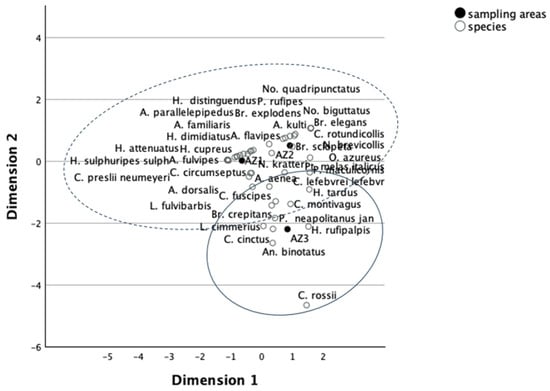
Figure 2.
Correspondence of carabid species and subspecies vs. sampling areas in two sampling periods (2017–2018). Two groups are shown in figure, one for AZ3 (area circled with solid line) and another for AZ1 and AZ2 (area circled with dotted line).
Throughout the two-year study period, the most abundant taxon was P. melas italicus, classified as eudominant, contributing 14.80% in AZ3, 17.10% in AZ1, and 30.45% in AZ2. This thermophilic and widely tolerant taxon is typical of open areas and crops, and is known as a generalist predator [9]. Another eudominant species, C. montivagus, widespread over the entire Italian territory [36], was collected in all three sites, with the highest percentage (24.30%) in AZ3. We observed the peak activity of Calathus fuscipes (Goeze, 1777), N. brevicollis and N. kratteri, P. melas italicus and Po. cupreus throughout all seasons. The mild winters and moderately warm summers in Calabria seem to have favored the activity of carabids, which remains regular throughout the year (Figure 3). The reduced number of species and individuals in AZ3, as reported in other studies [37], could be attributed to the presence of a dense herbaceous layer, which hinders the movement of carabids on the ground. The chorotype analysis, which involves assessing the distribution range of each carabid taxon, shows that the most common chorological categories of the collected taxa in the three hazelnut groves include European, Mediterranean, and Palearctic taxa (Table 2).
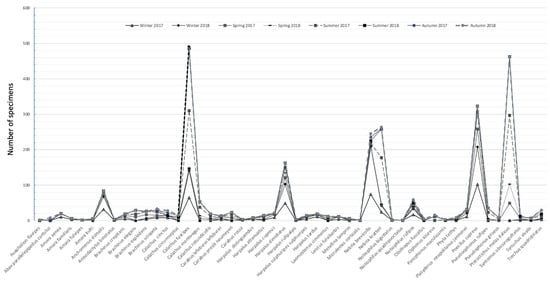
Figure 3.
Temporal distribution of carabid species and subspecies in sampled hazelnut groves during 2017–2018.
Furthermore, the presence of thermophilous forest carabids such as those belonging to the genus Carabus in sampling sites may depend on adjacent forest habitats, as shown in previous studies [38], and for other insect groups in Calabria [39] (Figure 2). Among the collected carabids, we found significant differences in abundance classes (Kruskal–Wallis test = 28.60; df = 2; p < 0.001) among the three sites (Figure 4). Throughout the sampling period, the eudominant class was distributed in all three sites, with six taxa exhibiting the highest abundance: C. montivagus, Po. cupreus, Ps. rufipes, P. melas italicus, S. obscuroguttatus, and N. brevicollis.
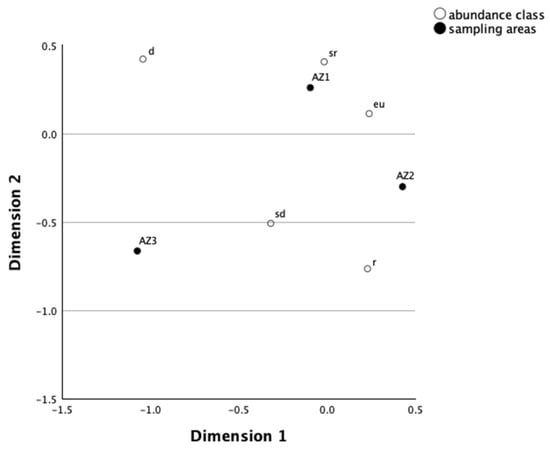
Figure 4.
Abundance classes of carabids collected in the sampled hazelnut groves. Abbreviations: d, dominant; eu, eudominant; r, recedent; sd, sub-dominant; sr, sub-recedent.
The dominant class was represented by only three taxa: C. cinctus, N. kratteri and Pl. neapolitanus jannonei. The subdominant class was represented by a total of 10 taxa, including Anchomenus dorsalis (Pontoppidan, 1763), Brachinus crepitans (Linnaeus, 1758), Brachinus explodens Duftschmid, 1812, Brachinus sclopeta (Fabricius, 1792), C. fuscipes, Calathus circumseptus Germar, 1823, Carabus lefebvrei lefebvrei Dejean, 1826, Harpalus dimidiatus (P. Rossi, 1790), Harpalus tardus (Panzer, 1797), and L. fulvibarbis, with higher abundance values observed in AZ3 compared to AZ1 and AZ2 (Table 2). The recedent taxa were evenly distributed among the three sites, while sub-recedent taxa were more frequent in AZ1 than in AZ2 and AZ3 (Figure 4).
Considering wing morphology (brachypterous, dimorphic, and macropterous), which is related to dispersion [40,41], significant differences (Kruskal–Wallis test = 146.3 p < 0.001, df = 2) were found among the taxa collected in the sampled groves (Table 2). Macropterous taxa represent the majority (68.75%) of the total taxa collected. These species possess metathoracic wings that enable them to fly for longer distances, indicating a high potential for dispersal [9]. Brachypterous species, that have reduced or non-functional wings, represent 20.83% of the total taxa collected. The reduction of functional wings in a carabid community may be connected to the fact that the brachypterous species can only survive in habitat characterized by a low degree of anthropogenic or natural disturbance [42,43,44,45]. Dimorphic taxa represent 10.42% of the total taxa collected. These species exhibit two distinct forms or morphs, often differing in wing length [46]. Macropterous species (Amara aenea (De Geer, 1774), Amara fulvipes (Audinet-Serville, 1821), Amara familiaris (Duftschmid, 1812)) and brachypterous species and subspecies (Ca. lefebvrei lefebvrei, Abax parallelepipedus curtulus Fairmaire, 1856, Calathus rotundicollis Dejean, 1828, C. montivagus) were more frequently sampled in AZ1 and AZ2 compared to AZ3 (Figure 5). Dimorphic species and subspecies (C. fuscipes, Harpalus sulphuripes sulphuripes German, 1824, Notiophilus biguttatus (Fabricius, 1779), and Notiophilus rufipes Curtis, 1829) were fewer in number but equally distributed across all groves, and C. fuscipes was particularly abundant in AZ3 (Figure 5). The predominance of macropterous taxa, especially in AZ1 and AZ2, suggests a higher potential for dispersal and colonization. Further research could explore the ecological implications of these findings, particularly in terms of population dynamics, habitat connectivity, and landscape-scale processes [8,43].
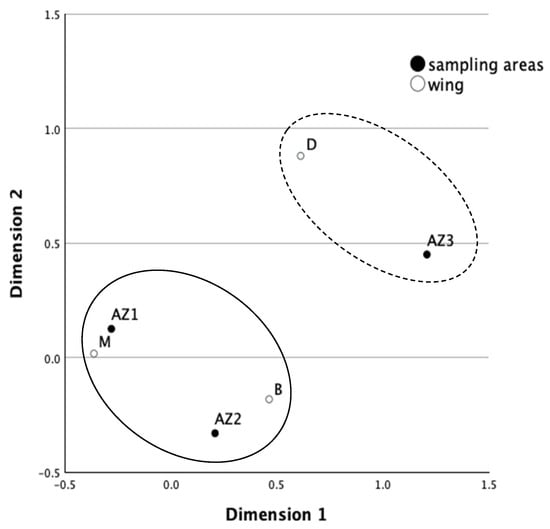
Figure 5.
Distribution of brachypterus, dimorphic and macropterus taxa among AZ1, AZ2 and AZ3 hazelnut groves sampled in 2017–2018.
Regarding diet, zoophagous taxa, with a wide range of prey [47], were the most abundant, representing 56.25% of the total species collected. Zoospermophagous taxa, capable of feeding on both prey and seeds [48], were the next most abundant, representing 31.25% of the total. Polyphagous taxa, which feed on a variety of food sources, represented 8.33% of the total. Spermophagous taxa, primarily feeding on seeds, were the least abundant, representing only 4.17% of the total. Among the spermophagous, Ps. rufipes was found, whose adults were described as mesophilic and feeding on seeds of various plants, while the larvae fed on other insects, pupae, and various invertebrates [49]. Figure 6 shows the distribution of ground beetle taxa across different trophic preferences (Figure 6A) and the most abundant ones within each category (Figure 6B).
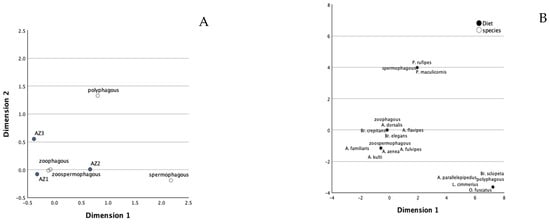
Figure 6.
Distribution of carabid taxa according to the trophic preference in sampled hazelnut groves in 2017–2018 (A) and the most abundant ones within each diet category (B).
Zoophagous and zoospermophagous taxa were the most frequently encountered trophic preferences across all sampled groves. Additionally, a group of polyphagous taxa was identified along Dimension axis 1 (Figure 6B), including B. sclopeta, A. parallelepipedus, La. cimmerius, and Olisthopus fuscatus Dejean, 1828. The spermophagous group included species such as Ps. rufipes and Parophonus maculicornis (Duftschmid, 1812). The zoophagous group was represented by An. dorsalis, B. crepitans, Brachinus elegans Chaudoir, 1842, and Asaphidion flavipes (Linnaeus, 1760). The zoospermophagous group included Am. familiaris, Am. aenea, Am. fulvipes, and Amara kulti Fassati, 1947. Among the various trophic preferences observed in hazelnut carabid communities, generalist predators (zoophagous) and opportunistic zoospermophagous taxa were apparently the dominant categories.
4. Conclusions
The hazelnut groves investigated in Calabria, compared to olive groves, were characterized by a lower level of taxa richness and number of captured specimens [9]. The ground beetles were active throughout the year, although their abundances were reduced during the winter months. Although previous data [50] show the relative stability of hazelnut groves, characterized by high levels of biodiversity, the results indicate that cultivation practices, typically involving the use of synthetic pesticides and fertilizers, could have detrimental effects on ground beetle populations. Chemical pesticides may directly kill ground beetles or indirectly affect their prey availability [6,51]. In organic farming, where chemical inputs are reduced, ground beetle populations may thrive [52]. However, as emerged in this study, the presence of a dense herbaceous layer, found in AZ3, hinders the movement of carabids on the ground [53]. The study allowed the importance of the ecotonal areas for the presence of taxa of ecological importance (e.g., Carabus spp.) to be verified. The forest marginal areas apparently promote greater habitat diversity, which favors the presence of zoophagous taxa such as those belonging to the genus Carabus spp., with a wide range of prey preferences [54,55]. It is known that spatial ecological heterogeneity can promote favorable small-scale effects on insect webs [56]. The natural heterogeneity of the marginal areas but also the limitation on the use of pesticides and other chemicals can lead to sustained populations of ground beetles and other beneficial insects [57,58]. However, while organic farming may generally promote higher species richness for ground beetles, specific outcomes can vary depending on factors such as the landscape, management practices, and regional differences [55]. Increasing habitat complexity within all agroecosystems with the use of hedgerows, field margins, and cover crops provides shelter, food, and breeding sites for carabids and other beneficial insects. It is important to educate farmers, agricultural professionals, and the broader community about the importance of carabids as antagonistic insects.
Author Contributions
Conceptualization, M.P. and T.B.; Data curation, M.P., D.B., F.C., E.D.B., F.F., F.M., C.M. and T.B.; Formal analysis, M.P. and T.B.; Investigation, M.P., D.B., F.C., E.D.B., F.F., F.M. and T.B.; Methodology, M.P. and T.B.; Supervision, M.P. and T.B.; Validation, M.P. and T.B.; Writing—original draft, M.P. and T.B.; Writing—review & editing, M.P., C.M. and T.B. All authors have read and agreed to the published version of the manuscript.
Funding
This research received no funding.
Institutional Review Board Statement
Not applicable.
Data Availability Statement
The data supporting this investigation are available from Marco Pezzi and Teresa Bonacci upon reasonable request.
Acknowledgments
The authors wish to thank Antonio Mazzei (Sistema Museale, Sezione Zoologia, Universitof Calabria, Rende, Cosenza, Italy) for his kind help in identifying the carabid taxa.
Conflicts of Interest
The authors declare no conflicts of interest.
References
- Nocciola tonda di Calabria: Un’eccellenza da scoprire. L’informatore agrario. Available online: https://www.informatoreagrario.it/filiere-produttive/frutticoltura/nocciola-tonda-di-calabria-uneccellenza-da-scoprire/ (accessed on 16 May 2023).
- AliNiazee, M.T. Ecology and management of hazelnut pests. Annu. Rev. Entomol. 1998, 43, 395–419. [Google Scholar] [CrossRef] [PubMed]
- Snare, L. Pest and Disease Analysis in Hazelnuts; Project No: NTO5OO2 (July 2006); Horticulture Australia Ltd.: Sydney, Australia, 2006; p. 64. [Google Scholar]
- Contarini, M.; Rossini, L.; Di Sora, N.; de Lillo, E.; Speranza, S. Monitoring the bud mite pest in a hazelnut orchard of Central Italy: Do plant height and irrigation influence the infestation level? Agronomy 2022, 12, 1982. [Google Scholar] [CrossRef]
- Mahr, D.; Whitaker, P.; Ridgeway, N. Biological Control of Insects and Mites—An Introduction to Beneficial Natural Enemies and Their Use in Pest Management; UW-Madison Division of Extension: Madison, Wisconsin, 2008; p. 116. [Google Scholar]
- Holland, J.M.; Luff, M.L. The effects of agricultural practices on Carabidae in temperate agroecosystems. Integr. Pest Manag. Rev. 2000, 5, 109–129. [Google Scholar] [CrossRef]
- Nietupski, M.; Kosewska, A.; Markuszewski, B.; Sądej, W. Soil management system in hazelnut groves (Corylus sp.) versus the presence of ground beetles (Coleoptera: Carabidae). J. Plant Prot. 2015, 55, 26–34. [Google Scholar] [CrossRef]
- Rainio, J.; Niemelä, J. Ground beetles (Coleoptera: Carabidae) as bioindicators. Biodivers. Conserv. 2003, 12, 487–506. [Google Scholar] [CrossRef]
- Pizzolotto, R.; Mazzei, A.; Bonacci, T.; Scalercio, S.; Iannotta, N.; Brandmayr, P. Ground beetles in Mediterranean olive agroecosystems: Their significance and functional role as bioindicators (Coleoptera, Carabidae). PLoS ONE 2018, 13, e0194551. [Google Scholar] [CrossRef] [PubMed]
- Kosewska, A.; Kędzior, R.; Nietupski, M.; Borkowski, J. Epigeic carabids (Coleoptera, Carabidae) as bioindicators in different variants of scots pine regeneration: Implication for forest landscape management. Sustainability 2023, 15, 13322. [Google Scholar] [CrossRef]
- Kromp, B. Carabid beetles in sustainable agriculture: A review on pest control efficacy, cultivation impacts and enhancement. Agric. Ecosyst. Environ. 1999, 74, 187–228. [Google Scholar] [CrossRef]
- Oberholzer, F.; Escher, N.; Frank, T. The potential of carabid beetles (Coleoptera) to reduce slug damage to oilseed rape in the laboratory. Eur. J. Entomol. 2003, 100, 81–85. [Google Scholar] [CrossRef]
- Twardowski, J.P.; Hurej, M.; Jaworska, T. An effect of strip management on carabid beetles (Col., Carabidae) in sugar beet crop. J. Plant Prot. 2006, 46, 61–71. [Google Scholar]
- Funayama, K. Influence of pest control pressure on occurrence of ground beetles (Coleoptera: Carabidae) in apple orchards. Appl. Entomol. Zool. 2011, 46, 103–110. [Google Scholar] [CrossRef]
- Vingiani, S.; Scarciglia, F.; Milet, F.A.; Donato, P.; Terribile, F. Occurrence and origin of soils with andic properties in Calabria (southern Italy). Geoderma 2014, 232–234, 500–516. [Google Scholar] [CrossRef]
- Arpacal (Agenzia Regionale per la Protezione dell’Ambiente della Calabria). Available online: https://www.cfd.calabria.it (accessed on 31 May 2023).
- Southwood, T.R.E. Ecological Methods with Particular Reference to the Study of Insect Populations; Chapman and Hall: New York, NY, USA, 1978; p. 524. [Google Scholar]
- O’Rourke, M.E.; Liebman, M.; Rice, M.E. Ground beetle (Coleoptera: Carabidae) assemblages in conventional and diversified crop rotation systems. Environ. Entomol. 2008, 37, 121–130. [Google Scholar] [CrossRef]
- Ward, M.J.; Ryan, M.R.; Curran, W.S.; Barbercheck, M.E.; Mortensen, D.A. Cover crops and disturbance influence activity-density of weed seed predators Amara aenea and Harpalus pensylvanicus (Coleoptera: Carabidae). Weed Sci. 2011, 59, 76–81. [Google Scholar] [CrossRef]
- Porta, A. Fauna Coleopterorum Italica. Vol. 3—Diversicornia; Stabilimento Tipografico Piacentino: Piacenza, Italy, 1929. [Google Scholar]
- Lindroth, C.H. The Carabidae (Coleoptera) of Fennoscandia and Denmark. Fauna Entomologica Scandinavica. Volume 15/1; Brill: Leiden, The Netherlands, 1985; pp. 1–226. [Google Scholar]
- Lindroth, C.H. The Carabidae (Coleoptera) of Fennoscandia and Denmark. Fauna Entomologica Scandinavica. Volume 15/2; Brill: Leiden, The Netherlands, 1986; pp. 1–274. [Google Scholar]
- Bousquet, Y.; Larochelle, A. Catalogue of the Geadephaga (Coleoptera: Trachypachidae, Rhysodidae, Carabidae including Cicindelini) of America North of Mexico. Mem. Ent. Soc. Can. 1993, 125 (Suppl. S167), 1–397. [Google Scholar] [CrossRef]
- Hůrka, K. Carabidae of the Czech and Slovak Republics; Kabourek: Zlin, Czech Republic, 1996; pp. 1–565. [Google Scholar]
- Ball, G.E.; Bousquet, Y. Carabidae Latreille, 1810. In American Beetles. Archostemata, Myxophaga, Adephaga, Polyphaga: Staphyliniformia; Arnett, R.H., Thomas, M.C., Jr., Eds.; CRC Press: Boca Raton, FL, USA, 2000; Volume 1, pp. 32–132. [Google Scholar]
- Allegro, G. An illustrated key to the species of the genus Pterostichus recorded from Italy (Coleoptera, Carabidae, Pterostichinae). Mem. Della Soc. Entomol. Ital. 2021, 98, 65–91. [Google Scholar] [CrossRef]
- Allegro, G.; Magrini, P.; Pavesi, M. Tabella illustrata di determinazione per le specie del genere Harpalus note in Italia (Coleoptera, Carabidae, Harpalinae). Boll.Soc. Entomol. Ital. 2022, 154, 51–86. [Google Scholar] [CrossRef]
- Käfer Europas; Die Käfer Europas; Ein Bestimmungswerk im Internet; Herausgegeben von Arved Lompe, Nienburg/Weser; Begründet im September 2002. Available online: http://coleonet.de/coleo/index.htm (accessed on 16 May 2023).
- Magistretti, M. Fauna d’Italia. Coleoptera, Cicindelidae, Carabidae. Catalogo topografico. Volume 8; Edizioni Calderini: Bologna, Italy, 1965; p. 512. [Google Scholar]
- Den Boer, P.J.; Van Huizen, T.H.I.; Den Boer-Daanje, W.; Aukema, B.; Den Bieman, C.F.M. Wing polymorphism and dimorphism in ground beetles as a stage in an evolutionary process (Coleoptera: Carabidae). Entomol. Gen. 1980, 6, 107–134. [Google Scholar] [CrossRef]
- Casale, A.; Sturani, M.; Vigna Taglianti, A. Coleoptera Carabidae. I. Introduzione, Paussinae, Carabinae. Fauna d’Italia 18; Calderini: Bologna, Italy, 1982; pp. 1–499. [Google Scholar]
- Vigna Taglianti, A.; Audisio, P.A.; Biondi, M.; Bologna, M.A.; Carpaneto, G.M.; De Biase, A.; Fattorini, S.; Piattella, E.; Sindaco, R.; Venchi, A.; et al. A proposal for a chorotype classification of the Near East fauna, in the framework of the Western Palearctic region. Biogeogr.-J. Integr. Biogeogr. 1999, 20, 31–59. [Google Scholar]
- Vigna Taglianti, A. Checklist e corotipi delle specie di Carabidae della fauna italiana. Appendice B. In I Coleotteri Carabidi per la valutazione ambientale e la conservazione della biodiversità. Manuale operativo; Brandmayr, P., Zetto, T., Pizzolotto, R., Eds.; APAT (Agenzia per la protezione dell’ambiente e per i servizi tecnici), Manuali e Linee Guida: Rome, Italy, 2005; Volume 34, pp. 186–225. [Google Scholar]
- Górny, M.; Grüm, L. Metody stosowane w zoologii gleby; PWN: Warsaw, Poland, 1981; pp. 1–483. [Google Scholar]
- Fisher, R.A. On the interpretation of χ² from contingency tables, and the calculation of P. J. R. Stat. Soc. 1922, 85, 87–94. [Google Scholar] [CrossRef]
- Migliorini, M.; Carapelli, A. Ground beetle assemblages in six different forest ecosystems from Tuscany (Central Italy) (Coleoptera: Carabidae). Fragm. Entomol. 2022, 54, 257–268. [Google Scholar]
- Pizzolotto, R.; Albertini, A.; Gobbi, M.; Brandmayr, P. Habitat diversity analysis along an altitudinal sequence of alpine habitats: The Carabid beetle assemblages as a study model. Period. Biol. 2016, 118, 241–254. [Google Scholar] [CrossRef]
- Deuschle, J.; Glück, E. Similarity of ground beetle communities of extensively managed orchards depending on management regimes. Bull. Insectology 2008, 61, 73–80. [Google Scholar]
- Gargano, D.; Fenu, G.; Bernardo, L. Local shifts in floral biotic interactions in habitat edges and their effect on quantity and quality of plant offspring. AoB Plants 2017, 9, plx031. [Google Scholar] [CrossRef] [PubMed]
- Desender, K.; Maelfait, J.P.; Vaneechoutte, M. Allometry and evolution of hind wing development in macropterous carabid beetles. In Carabid Beetles. Their Adaptations and Dynamics; Den Boer, P.J., Luff, M.L., Mossakowski, D., Weber, F., Eds.; Gustav Fisher: Stuttgart, Germany, 1986; pp. 101–112. [Google Scholar]
- Brandmayr, P.; Zetto, T.; Pizzolotto, R. I Coleotteri Carabidi per la valutazione ambientale e la conservazione della biodiversità. Manuale operativo; APAT (Agenzia per la protezione dell’ambiente e per i servizi tecnici), Manuali e Linee Guida: Rome, Italy, 2005; Volume 34, p. 240. [Google Scholar]
- Brandmayr, P. The main axes of the coenoclinal continuum from macroptery to brachyptery in carabid communities of the temperate zone. In The Synthesis of Field Study and Laboratory Experiment in Carabids. Report of the Fourth Meeting of European Carabidologists; Brandmayr, P., Boer, J., Weber, F., Eds.; PUDOC: Wageningen, The Netherlands, 1983; pp. 147–169. [Google Scholar]
- Lövei, G.L.; Sunderland, K.D. Ecology and behavior of ground beetles (Coleoptera: Carabidae). Annu. Rev. Entomol. 1996, 41, 231–256. [Google Scholar] [CrossRef]
- Kotze, D.J.; Niemelä, J.; O’Hara, R.B.; Turin, H. Testing abundance-range size relationships in European carabid beetles (Coleoptera, Carabidae). Ecography 2003, 26, 553–566. [Google Scholar] [CrossRef]
- Gobbi, M.; Fontaneto, D. Biodiversity of ground beetles (Coleoptera: Carabidae) in different habitats of the Italian Po lowlands. Agric. Ecosyst. Environ. 2008, 127, 273–276. [Google Scholar] [CrossRef]
- Den Boer, P.J. Dispersal power and survival. Carabids in a cultivated countryside. Landbouwhogesch. Misc. Pap. 1977, 14, 1–190. [Google Scholar]
- Holopainen, J.K.; Helenius, J. Gut contents of ground beetles (Col., Carabidae), and activity of these and other epigeal predators during an outbreak of Rhopalosiphum padi (Hom., Aphididae). Acta Agric. Scand.-B Soil Plant Sci. 1992, 42, 57–61. [Google Scholar]
- Lupi, D.; Colombo, M.; Facchini, S. The ground beetles (Coleoptera: Carabidae) of three horticultural farms in Lombardy, Northen Italy. Boll. Zool. Agr. Bachic. Ser II 2007, 39, 193–209. [Google Scholar]
- Luff, M.L. Biology of polyphagous ground beetles in agriculture. Agric. Zool. Rev. 1987, 2, 237–278. [Google Scholar]
- Integrated Pest Management for Hazelnut Crops a Practical Handbook. Available online: https://www.accioncontraelhambre.org/sites/default/files/documents/ipm_guide_eng.pdf (accessed on 16 May 2023).
- Gurr, G.M.; Wratten, S.D.; Altieri, M.A. Ecological Engineering for Pest Management: Advances in Habitat Manipulation for Arthropods; CSIRO Publishing: Collingwood, VIC, Australia, 2004; pp. 1–238. [Google Scholar]
- Rusch, A.; Bommarco, R.; Chiverton, P.; Öberg, S.; Wallin, H.; Wiktelius, S.; Ekbom, B. Response of ground beetle (Coleoptera, Carabidae) communities to changes in agricultural policies in Sweden over two decades. Agric. Ecosyst. Environ. 2013, 176, 63–69. [Google Scholar] [CrossRef]
- Pizzolotto, R.; Brandmayr, P.; Mazzei, A. Carabid beetles in a Mediterranean Region: Biogeographical and ecological features. In European Carabidology 2003, Proceedings of the 11th European Carabidologist Meeting, Århus, Denmark, 21–24 July 2003; Lövei, G.L., Toft, S., Eds.; Report Plant Production No 114; Danish Institute of Agricultural Sciences: Tjele, Denmark, 2005; pp. 243–254. [Google Scholar]
- Marshall, E.J.P.; Moonen, A.C. Field margins in northern Europe: Their functions and interactions with agriculture. Agric. Ecosyst. Environ. 2002, 89, 5–21. [Google Scholar] [CrossRef]
- Holland, J.M.; Bianchi, F.J.; Entling, M.H.; Moonen, A.C.; Smith, B.M.; Jeanneret, P. Structure, function and management of semi-natural habitats for conservation biological control: A review of European studies. Pest Manag. Sci. 2016, 72, 1638–1651. [Google Scholar] [CrossRef] [PubMed]
- Caruso, T.; Trokhymets, V.; Bargagli, R.; Convey, P. Biotic interactions as a structuring force in soil communities: Evidence from the micro-arthropods of an Antarctic moss model system. Oecologia 1999, 74, 157–165. [Google Scholar]
- Paoletti, M.G.; Hassall, M. Woodlice (Isopoda: Oniscidea): Their potential for assessing sustainability and use as bioindicators. Agric. Ecosyst. Environ. 1999, 74, 157–165. [Google Scholar] [CrossRef]
- Sunderland, K.D.; Samu, F. Effects of agricultural diversification on the abundance, distribution, and pest control potential of spiders: A review. Entomol. Exp. Appl. 2000, 95, 1–13. [Google Scholar] [CrossRef]
Disclaimer/Publisher’s Note: The statements, opinions and data contained in all publications are solely those of the individual author(s) and contributor(s) and not of MDPI and/or the editor(s). MDPI and/or the editor(s) disclaim responsibility for any injury to people or property resulting from any ideas, methods, instructions or products referred to in the content. |
© 2024 by the authors. Licensee MDPI, Basel, Switzerland. This article is an open access article distributed under the terms and conditions of the Creative Commons Attribution (CC BY) license (https://creativecommons.org/licenses/by/4.0/).